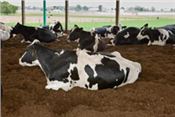Cow Comfort Is A Top Priority For New UK Dairy Facility

Comfy cows in a similar facility – Bowling Green, Ky.
PHOTO: Steve Patton, UK Agricultural Communications
LEXINGTON, KY.
Dairy cows at the University of Kentucky will soon be enjoying more luxurious accommodations. Officials at the UK College of Agriculture, Food and Environment recently broke ground at the Coldstream Dairy Research Farm and began building a new home for the herd with comfort and ease of living in mind.
The name for the new barn will be the Dairy Housing, Teaching and Research Facility, and it is the only facility of its kind at a research institution in the United States. The herd is currently housed in a freestall barn built in the 1960s. Although that type of facility is still the predominant housing system for dairy cows, UKAg officials wanted to try something new.
“This type of facility does not have any stalls,” said Jeffrey Bewley, UKAg dairy specialist. “Instead, cows will be able to lie down in any position they want to within the barn. This has great potential to improve feet and leg health.”
The barn will have a concrete, center lane that will allow access for a tractor and mixer wagon to come through and deliver feed. The cows will also be able to walk down an adjacent alley to access food and water. They will rest in the open bedding areas between feedings and milkings.
“It will be a tall, open barn designed to maximize natural ventilation, and it will be supplemented with fans and sprinklers for cooling,” Bewley said. “It’s designed to maximize cow comfort. The open bedding area provides a comfortable place for cows to lie down, and the cooling features will help our animals deal with hot and humid weather.”
The cow’s bedding is the main reason for their improved health and overall comfort. Bewley said it starts with about 12 inches of sawdust. Cows naturally add to the sawdust with manure and urine. Twice a day, while the cows are out milking, the bedding gets mechanically stirred and mixed to form a surprisingly dry material with minimal odor where cows can rest. Employees periodically will add fresh bedding to the mix.
“This is a very environmentally friendly concept,” Bewley said. “It will greatly reduce the volume of organic matter that has traditionally had to be removed from dairy facilities. It also significantly reduces the odor coming from the dairy, and it may even reduce the fly population.”
“This is an important, alternative manure-management practice that allows flexibility in utilization of plant nutrients and organic matter for soil fertility,” said Joseph Taraba, specialist in the Department of Biosystems and Agricultural Engineering.
Cows will have access to a grooming brush anytime they need it. The barn will have curtains to protect cows from rain and colder temperatures. The curtains are automated, and a controller will raise them up and down based on ambient conditions. The facility will also incorporate multiple precision dairy technologies, which will allow UKAg researchers to understand the cow’s behavioral and physiological response to her physical environment in ways not possible a few years ago.
“This relatively new housing system has been one that has worked very well for Kentucky farmers, and we’ve established ourselves as a leader in this area,” said Richard Coffey, department chair for the UK Department of Animal and Food Sciences. “We are building this to understand this system better and to ultimately help Kentucky farmers. This could be a real solution for them in terms of cow comfort and health.”
The UK dairy has a milking herd of around 100 Holstein cows that each average nearly 24,000 pounds of milk each year. The dairy farm facilities give undergraduate students a chance to observe a functional dairy operation as part of their courses. The students get extensive hands-on experience in practical dairy management techniques. The farm hosts many dairy extension programs and demonstrations that allow Kentucky dairy farmers to learn about the latest management practices, technology and research. ∆
|
|